Family Name: Linaceae DC. ex Perleb
Synonym(s): Hugoniaceae Arn.
Common Name(s): flax family
*Number of genera/species: 10/255
List of genera records in GRIN-Global
Fruit usually a septicidalsepticidal:
type of capsular dehiscence, opening longitudinally by separating between the septa of adjacent carpels
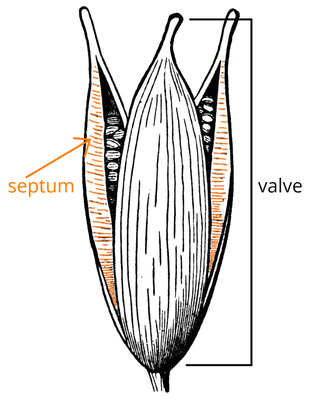 capsulecapsule:
capsulecapsule:
a dry, dehiscent fruit derived from a compound ovary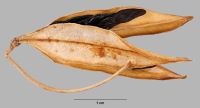 , carpels (2, 3 or 5) only connate basally, each carpelcarpel:
, carpels (2, 3 or 5) only connate basally, each carpelcarpel:
a simple pistil that consists of a single ovary, style, and stigma
dehiscing into 2 one-seeded segments separated by false septaseptum:
(pl. septa) a dividing cross wall or partition
 . Or sometimes a drupedrupe:
. Or sometimes a drupedrupe:
(indehiscent drupe) a fleshy, indehiscent fruit with one more hard pits enclosing seeds, derived from single, superior, simple or compound ovary; (dehiscent drupe) a fruit with a dry or fibrous to fleshy or leathery outer husk that early to tardily breaks apart (or opens), exposing one or more nutlike pits enclosing the seeds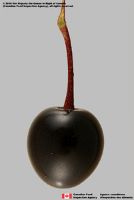 or rarely a schizocarpschizocarp:
or rarely a schizocarpschizocarp:
usually dry fruit splitting between two or more locules to form distinct, indehiscent, usually one seeded segments; fruit derived from a single, superior or inferior, compound ovary; compare to mericarp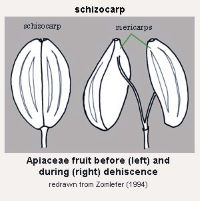 breaking into 2 or 4 one-seeded nutletsnutlet:
breaking into 2 or 4 one-seeded nutletsnutlet:
˜achene
. Fruits 1–19 mm, globoseglobose:
3D shape—more or less spherical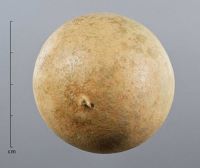 to triangulartriangular:
to triangulartriangular:
2D shape—three relatively straight sides with distinct corners; more angular than teardrop-shaped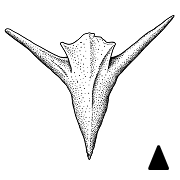 , tereteterete:
, tereteterete:
approximately circular in cross section; width and thickness approximately equal
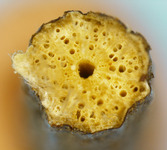 in transection, with 1–10 seeds, sometimes surrounded by persistent calyxcalyx:
in transection, with 1–10 seeds, sometimes surrounded by persistent calyxcalyx:
the outer whorl of the perianth; all the sepals of a flower . Pericarppericarp:
. Pericarppericarp:
fruit wall or fruit coat
yellow, sometimes with purple-hued apexapex:
the point farthest from the point of attachment, or the "tip" of an organ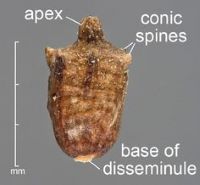 , or brown, smooth, glabrousglabrous:
, or brown, smooth, glabrousglabrous:
without hairs
, sometimes pilosepilose:
having thin, soft, long hairs
. CapsulesCapsule:
a dry, dehiscent fruit derived from a compound ovary thin- or thick-walled, fragile, membranousmembranous:
thin- or thick-walled, fragile, membranousmembranous:
texture—extremely thin, pliable, and fairly tough
, or cartilaginouscartilaginous:
texture—firm, dense, tough, somewhat pliable, and resilient, like cartilage
. DrupesDrupe:
(indehiscent drupe) a fleshy, indehiscent fruit with one more hard pits enclosing seeds, derived from single, superior, simple or compound ovary; (dehiscent drupe) a fruit with a dry or fibrous to fleshy or leathery outer husk that early to tardily breaks apart (or opens), exposing one or more nutlike pits enclosing the seeds fleshy, sometimes thinly fleshy.
fleshy, sometimes thinly fleshy.
Seeds compressedcompressed:
flattened; in grasses, used to denote compression (not necessarily flattened) either laterally or dorsiventrally
or flattened, lenticularlenticular:
3D shape—lens-shaped; biconvex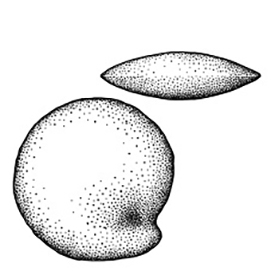 to reniformreniform:
to reniformreniform:
2D or 3D shape—kidney-shaped , triangulartriangular:
, triangulartriangular:
2D shape—three relatively straight sides with distinct corners; more angular than teardrop-shaped or wedge-shapedwedge-shaped:
or wedge-shapedwedge-shaped:
2D shape—triangular and tapering to a point at the base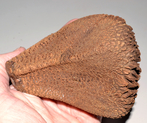 in transection, 0.4–6 mm. Sometimes arillate (Indorouchera, Philbornea) or with membranousmembranous:
in transection, 0.4–6 mm. Sometimes arillate (Indorouchera, Philbornea) or with membranousmembranous:
texture—extremely thin, pliable, and fairly tough
wing (Reinwardtia, Tirpitzia). Seed coat black, brown, or reddish brown, shinyshiny:
uniformly reflecting a high proportion of incident light at all angles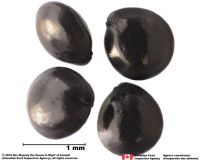 or dulldull:
or dulldull:
reflecting only a low proportion of incident light, with no apparent sheen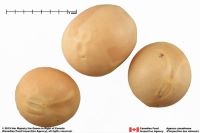 , coriaceouscoriaceous:
, coriaceouscoriaceous:
texture—leathery
, often mucilaginousmucilaginous:
resembling mucilage; moist and sticky
, smooth or reticulatereticulate:
surface relief—netted, raised walls or concave grooves forming a net-like surface pattern with flat, concave, or convex interspaces , glabrousglabrous:
, glabrousglabrous:
without hairs
.
Embryo well developed, completely to nearly filling seed cavity, axileaxile:
on or of the axis
and centric, foliatefoliate:
appearing leaf-like
, parallel to seed length, straight or slightly curvedcurved:
(of embryo) linear embryo is curved into an arch or horseshoe with the ends far apart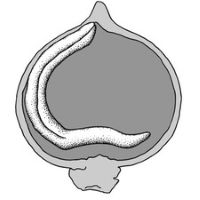 , with spatulatespatulate:
, with spatulatespatulate:
2D shape—like a spatula; rounded at the apex, with base long and tapered; (of embryo) embryo is straight and axile and centric with the cotyledons expanded to form the shape of a spatula or spoon; (of cotyledons) cotyledons expanded and wider than the stalk but not invested into the stalk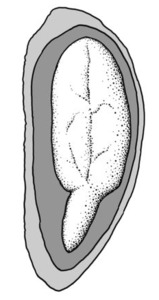 or investinginvesting:
or investinginvesting:
(of embryo) embryo is nearly or completely filling seed coat, straight, and axile and centric with spatulate cotyledons and covering the stalk for at least half its length; (of cotyledons) cotyledons spatulate and covering the stalk for at least half its length
cotyledons.
Endosperm usually scanty, sometimes copious, if present fleshy-soft.
| Fruit | |
| Type | septicidalsepticidal: type of capsular dehiscence, opening longitudinally by separating between the septa of adjacent carpels  capsulecapsule: capsulecapsule:a dry, dehiscent fruit derived from a compound ovary  , drupedrupe: , drupedrupe:(indehiscent drupe) a fleshy, indehiscent fruit with one more hard pits enclosing seeds, derived from single, superior, simple or compound ovary; (dehiscent drupe) a fruit with a dry or fibrous to fleshy or leathery outer husk that early to tardily breaks apart (or opens), exposing one or more nutlike pits enclosing the seeds  , schizocarpschizocarp: , schizocarpschizocarp:usually dry fruit splitting between two or more locules to form distinct, indehiscent, usually one seeded segments; fruit derived from a single, superior or inferior, compound ovary; compare to mericarp  |
| Size range | 1–19 mm long |
| Shape(s) | globoseglobose: 3D shape—more or less spherical  , ellipsoidellipsoid: , ellipsoidellipsoid:3D shape—elliptic , ovoidovoid: 3D shape—ovate 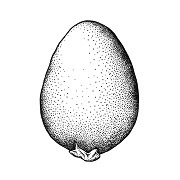 , oblongoblong: , oblongoblong:2D shape—much longer than broad with nearly parallel sides, corners are rounded  , triangulartriangular: , triangulartriangular:2D shape—three relatively straight sides with distinct corners; more angular than teardrop-shaped  , pear-shaped , pear-shaped |
| Texture | capsulescapsule: a dry, dehiscent fruit derived from a compound ovary  - fragile, membranousmembranous: - fragile, membranousmembranous:texture—extremely thin, pliable, and fairly tough , cartilaginouscartilaginous: texture—firm, dense, tough, somewhat pliable, and resilient, like cartilage , thick-walled drupes - fleshy |
| Surface relief | smooth |
| Color(s) | yellow, sometimes with purple hues on upper portion, brown |
| Unique features | Usually yellow or brown septicidalsepticidal: type of capsular dehiscence, opening longitudinally by separating between the septa of adjacent carpels  capsulescapsule: capsulescapsule:a dry, dehiscent fruit derived from a compound ovary  splitting into 4–10, 1-seeded segments, remaining basally connate. Sometimes yellow or brown, fleshy drupesdrupe: splitting into 4–10, 1-seeded segments, remaining basally connate. Sometimes yellow or brown, fleshy drupesdrupe:(indehiscent drupe) a fleshy, indehiscent fruit with one more hard pits enclosing seeds, derived from single, superior, simple or compound ovary; (dehiscent drupe) a fruit with a dry or fibrous to fleshy or leathery outer husk that early to tardily breaks apart (or opens), exposing one or more nutlike pits enclosing the seeds  with up to 10 seeds, sometimes splitting into indehiscentindehiscent: with up to 10 seeds, sometimes splitting into indehiscentindehiscent:not opening on its own, as in a fruit  mericarps. Fruits often with mucilaginousmucilaginous: mericarps. Fruits often with mucilaginousmucilaginous:resembling mucilage; moist and sticky seeds. |
| Seed | |
| Size range | 0.4–6 mm long |
| Shape(s) | lenticularlenticular: 3D shape—lens-shaped; biconvex  , ellipsoidellipsoid: , ellipsoidellipsoid:3D shape—elliptic , ovoidovoid: 3D shape—ovate  , oblongoblong: , oblongoblong:2D shape—much longer than broad with nearly parallel sides, corners are rounded  , reniformreniform: , reniformreniform:2D or 3D shape—kidney-shaped  |
| Surface relief | smooth, reticulatereticulate: surface relief—netted, raised walls or concave grooves forming a net-like surface pattern with flat, concave, or convex interspaces  |
| Color(s) | black, brown, reddish brown |
| Unique features | Small dark seeds, compressedcompressed: flattened; in grasses, used to denote compression (not necessarily flattened) either laterally or dorsiventrally or flattened, usually smooth and often mucilaginousmucilaginous: resembling mucilage; moist and sticky . |
| Other | |
| Embryo | well developed, completely to nearly filling seed cavity, axileaxile: on or of the axis and centric, foliatefoliate: appearing leaf-like , parallel to seed length, straight or slightly curvedcurved: (of embryo) linear embryo is curved into an arch or horseshoe with the ends far apart  , with spatulatespatulate: , with spatulatespatulate:2D shape—like a spatula; rounded at the apex, with base long and tapered; (of embryo) embryo is straight and axile and centric with the cotyledons expanded to form the shape of a spatula or spoon; (of cotyledons) cotyledons expanded and wider than the stalk but not invested into the stalk  or investinginvesting: or investinginvesting:(of embryo) embryo is nearly or completely filling seed coat, straight, and axile and centric with spatulate cotyledons and covering the stalk for at least half its length; (of cotyledons) cotyledons spatulate and covering the stalk for at least half its length cotyledons |
| Nutritive tissue | endosperm usually scanty, sometimes copious, if present fleshy-soft |
Worldwide
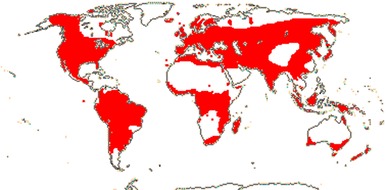
Distribution map courtesy of Angiosperm Phylogeny Website.
Flora of North America Editorial Committee 1993+Flora of North America Editorial Committee 1993+:
Flora of North America Editorial Committee, eds. 1993+. Flora of North America North of Mexico [Online]. 22+ vols. Flora of North America Association, New York and Oxford. Accessed January-March 2024. URL: http://beta.floranorthamerica.org.; González-Velasco et al. 2022González-Velasco et al. 2022:
González-Velasco J, Burgos M, Galván-Escobedo I, and Castillo-Campos G. 2022. Taxonomic update of the flax family in Mexico. Phytotaxa 549: 141–184. https://doi.org/10.11646/phytotaxa.549.2.3; Kirkbride et al. 2006Kirkbride et al. 2006:
Kirkbride JH, Jr, Gunn CR, and Dallwitz MJ. 2006. Family guide for fruits and seeds, vers. 1.0. Accessed September 2020-January 2022. URL: https://nt.ars-grin.gov/seedsfruits/keys/frsdfam/index.cfm .; Kubitzki et al. 1990+Kubitzki et al. 1990+:
Kubitzki K et al., eds. 1990+. The families and genera of vascular plants. 7+ vols. Berlin etc.; Takhtajan 2009Takhtajan 2009:
Takhtajan A. 2009. Flowering plants: Second edition. Springer Nature, Switzerland. 871 pp.; Zhengyi et al. 2004+Zhengyi et al. 2004+:
Zhengyi W, Raven PH, and Deyuan H. 2004+. Flora of China [online]. 25 vols. Science Press, Beijing China & Missouri Botanical Garden, St. Louis USA. Accessed January–March 2024. http://flora.huh.harvard.edu/china/
*The number of genera and species is based on Christenhusz and Byng 2016Christenhusz and Byng 2016:
Christenhusz MJM and Byng JW. 2016. The number of known plant species in the world and its annual increase. Phytotaxa 261 (3): 201-217. https://doi.org/10.11646/phytotaxa.261.3.1, which may differ from the number of genera in GRIN-Global.